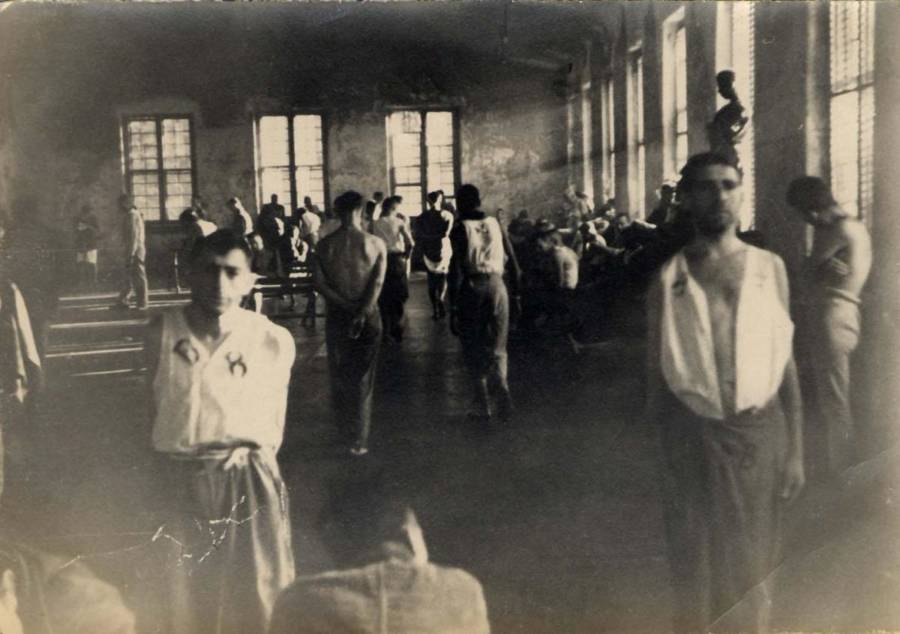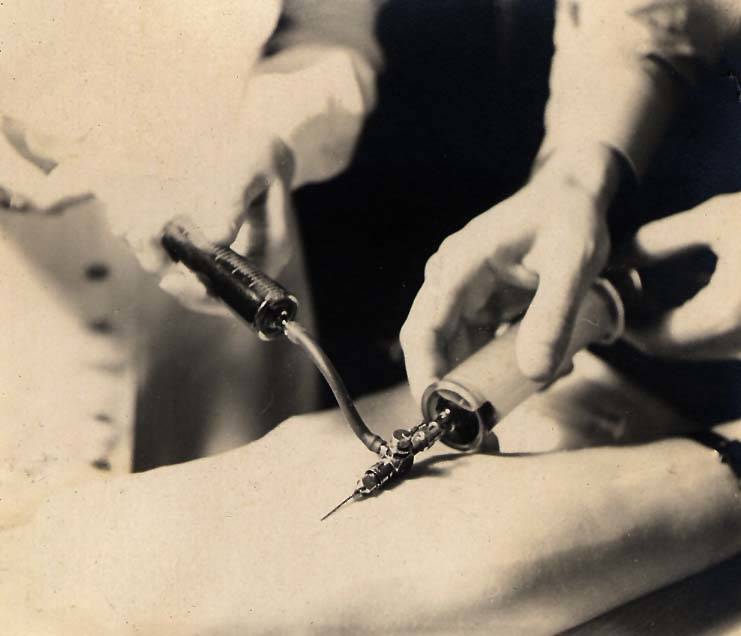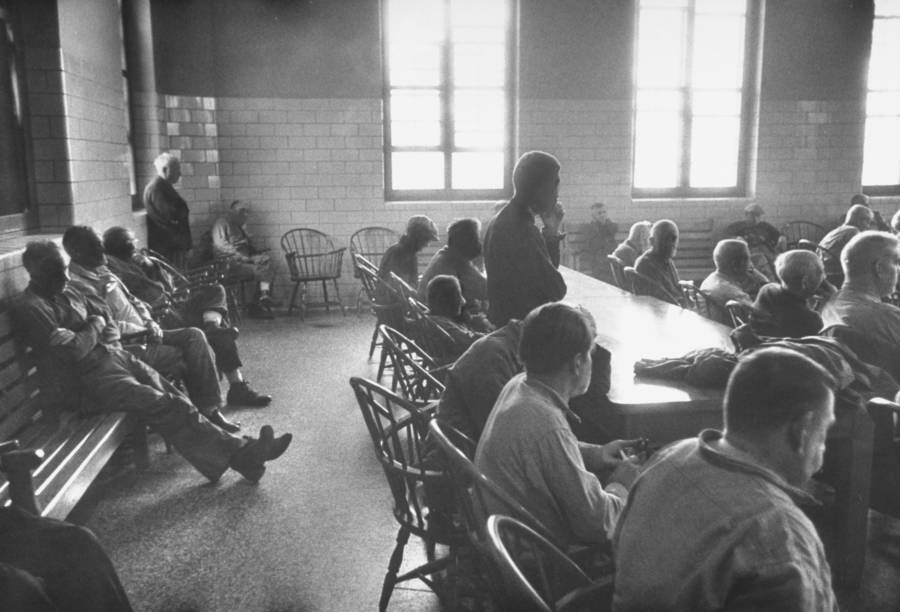The Philadelphia State Hospital at Byberry tormented its patients with almost no consequences from its opening in 1911 until it was finally shut down in 1990.

Public DomainThe “violent ward” at Byberry mental hospital. 1943.
“Thousands spend their days – often for weeks at a stretch – locked in devices euphemistically called ‘restraints’: thick leather handcuffs, great canvas camisoles, ‘muffs,’ ‘mitts,’ wristlets, locks and straps and restraining sheets. Hundreds are confined in ‘lodges’ – bare, bed-less rooms reeking with filth and feces – by day lit only through half-inch holes in steel-plated windows, by night merely black tombs in which the cries of the insane echo unheard from the peeling plaster of the walls.”
While the description above sounds like something out of a horror movie, it actually comes from a 1946 LIFE Magazine exposé of Philadelphia’s Byberry mental hospital.
Even today, inhumane conditions and patient abuse are the main legacies of the Byberry mental hospital (officially known as the Philadelphia State Hospital).
What started out as a working farm for a few unstable patients at a time in 1903 eventually grew into a multi-building campus. Although it relieved overcrowding from the other mental facilities in the area, it grew so fast that it couldn’t entice enough staff to work there.
Soon, facility administrators were letting people work there even if they weren’t especially qualified — if you needed a job, you had one. Perhaps some that were employed there even fit the bill for admission.
At the same time, close to 3,000 conscientious objectors who didn’t fight in World War II for religious reasons were sent to work at mental hospitals around the country. It was largely via these pacifists’ accounts and photographs that the abusive conditions inside Byberry mental hospital were finally brought to light.
Although some dedicated, caring, and hard-working staff at the Byberry mental hospital truly cared for the patients, a number of bad employees carried out abuses that remain disturbing to this day.
Neglect At Byberry Mental Hospital
Due to the understaffing, there was an extremely low ratio of orderlies to patients at the Byberry mental hospital. Because of this, residents were often left unbathed and naked. Housekeeping fell behind, bedding was unwashed, and floors were sticky with urine. Instead of tending to the patients, staff put them in four-point restraints — sometimes for months at a time.
As recently as the late 1980s, 27-year-old resident William Kirsch was in such restraints for more than 14 months — and possibly as long as three years. The U.S. District Court for Eastern Pennsylvania found that Byberry was infringing on Kirsch’s human rights, and demanded his release from the hospital. “I hope that the state has not injured this poor young man to the point where it is now irreparable,” said his attorney, Stephen Gold. “He was much better when he went in there seven or eight years ago.”
By 1970, more than a decade before Kirch’s case even, there were at least 57 deaths attributed solely to patient neglect at Byberry mental hospital — and probably many more that went unreported.
On the other hand, Byberry’s open-door policy for high-functioning residents made it easy for certain people to escape. Homeowners in the area sometimes found patients sleeping on their lawns. However, some patients who wandered off ended up committing suicide not far from the hospital.
One patient escaped on a cold February day. But when he reconsidered his decision, he couldn’t find any staff to let him back inside. He died of exposure.

Wayne D. Sawyer Papers in Civilian Public Service: Personal Papers & Collected Material (DG 056), Swarthmore College Peace Collection./span>A staff member administers a shot to a patient at Byberry mental hospital. 1944.
The Infamous ‘Water Cure’ At Byberry
A 1946 newspaper article from the Philadelphia Record describes Byberry’s “water cure”:
“[An attendant] soaked a large towel in water. After wringing it out, he clamped the towel around the patient’s neck. The attendant pulled the ends together, and began to twist. First he tightened the noose. Then he gave the towel a slow turn to let the patient know what was in store for him. The patient begged for mercy. But the twisting continued. The patient’s eyes bulged, his tongue swelled, his breathing labored. At length, his body fell back on the bed. His face was a dreadful white, and he did not appear to be breathing. Fifteen minutes elapsed before he showed signs of returning to life. The patient was ‘subdued’.”
This act left no physical marks on the body, and could easily fly under the radar of investigators.
As was the case with the water cure, other beatings and assorted abuses by staff members at the Byberry mental hospital likely went unnoticed. One conscientious objector working at the hospital reported that attendants were careful not to be seen when using “weapons or fists upon patients,” attacks which undoubtedly resulted in life-threatening injuries and death.
Medication Becomes A Tool Of Torment
Some of the most excruciating abuses at the Byberry mental hospital came during the course of “treatment.” Doctors pulled teeth without administering novocaine, for example, and performed other medical procedures without painkillers.
Larry Real, a psychiatrist who trained briefly at the Byberry mental hospital in the 1970s, recalled a Byberry staff member trying to give a patient stitches sans painkillers. “The doctor had been taught that people with schizophrenia did not feel pain.”
In stark contrast to the underuse of painkillers, other medications were overused in ways that were just as dangerous. Thorazine, for one, was once hailed as the next miracle drug, and administered freely at Byberry.
The pharmaceutical company Smith Kline-French even opened a lab inside Byberry, and did extensive (and morally questionable) testing of the drug there.
Unable to fully understand and consent and in some cases without family members to notify if a fatality occurred, patients were coerced into “volunteering” for these drug trials. Ultimately, hundreds of patients at the Byberry mental hospital died during these trials.

Werner Wolff/The LIFE Images Collection/Getty ImagesPatients sit in a common area at the Byberry mental hospital. 1951.
Abuse At Byberry Escalated To Murder
In 1919, two orderlies at the Byberry mental hospital confessed to strangling a patient until his eyes popped out. The orderlies blamed their actions on having PTSD from World War I. Not only were they not prosecuted, they were kept on staff — at a higher pay grade.
In addition to cases of staff killing patients, cases of patients killing other patients also piled up. On top of the mentally unstable, Byberry also housed many criminals sent there to undergo “psychiatric testing” in lieu of prison.
One patient even attempted murder with a sharpened spoon in 1944. According to Warren Sawyer, a conscientious objector and staff member, the man “went to another patient and jabbed him in the side of the neck on top of his shoulder and drove the spoon down about one inch deep, just missing the jugular vein.”
One female patient was raped, killed, and discarded on the property by a fellow patient in 1987. The staff finally discovered her body after other residents were found carrying around her teeth.
Two more dead patients were recovered from the property in 1989, when groundskeepers cleared the weeds that had accumulated around the building. One of these patients had been missing for close to five months. It seems as though there were a few residents who simply just “went missing” and nobody had time to look for them.
Byberry Is Finally Shut Down
Despite reports from Byberry circulating and sparking horror nationwide for decades, it remained in operation until almost 1990.
As early as 1946, Life magazine published shocking photos taken by Charles Lord depicting the atrocious conditions within. First Lady Eleanor Roosevelt was reportedly horrified by what she saw.
Author Albert Deutsch wrote in a 1948 book after a tour of the facility:
“As I passed through some of Byberry’s wards, I was reminded of the pictures of the Nazi concentration camps. I entered a building swarming with naked humans herded like cattle and treated with less concern, pervaded by a fetid odor so heavy, so nauseating, that the stench seemed to have almost a physical existence of its own.”
In the 1980s, however, then-anonymous accounts by patient Anna Jennings made their way to state officials. Jennings had been abused as a child and was diagnosed with schizophrenia — but she still had the wherewithal to document instances of abuse she saw and smuggle them to her mother.
Luckily, Jennings’ mother worked in state mental health oversight, and soon a committee was investigating Byberry that uncovered abuse and a culture of covering up that abuse.
Finally, on June 21, 1990, after decades of controversy, the Byberry mental hospital closed its doors.
After this look at Byberry mental hospital, step inside some more of the most disturbing mental asylums of decades past. Then, see what life was like inside the mental asylums of Victorian England. Finally, see what life was like for the famous actress who was involuntarily institutionalized.





